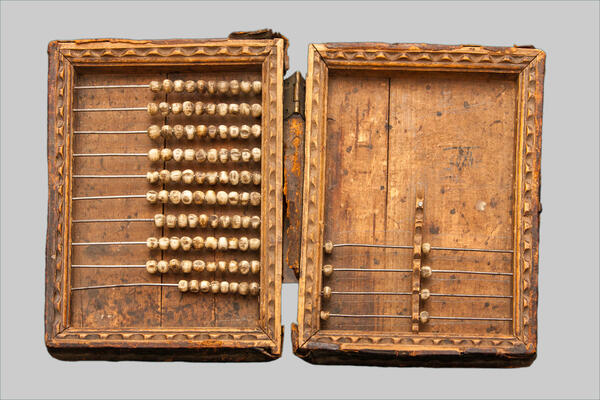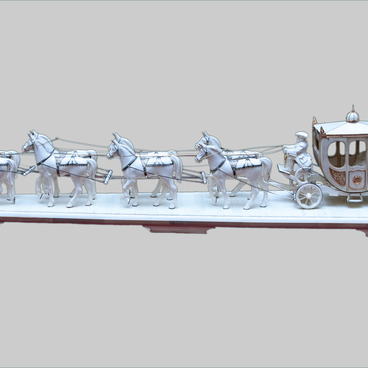The need for counting and measurement appeared in the old days. At first, people used pebbles, grains, and fingers when counting. As the calculations became more complex, devices were invented to help make the process easier. One of these tools was the abacus. According to some preserved sources, the abacus was invented by the Chinese, according to others — this device is a true Russian invention, created to facilitate the calculation of the decimal system, which existed in the Moscow state in the 16th century. In China, the fivefold system was adopted at that time.
The abacus presented in the exhibition consists of two folding wooden boxes covered with leather. The device is made in the form of a book with copper hinges, inside which metal rods with small bones with cavities on the sides are stretched from side to side. The edges of the ‘book’ are decorated with carvings.
The left board has a set for counting integers, and dibs are strung on for fractions in the lower part of the right board divided in half. The second counting field allowed for a stock of dibs that are useful for the operations of multiplication and division. According to the provisions of the ancient Russian tax arithmetic, fractions were constructed on the principle of sequential division in half of two initial fractional quantities: quarters and thirds.
It is known that abacus was actively used in tax accounting. In the 17th century, various types of taxation were used in Russia, including tax collected from each plow (‘pososhny’), when land was taxed. The word ‘pososhny’ comes from the word ‘plow’ (‘soha’) — a wooden tool for plowing land in medieval times. The main payers of this tax were peasants. To take account of the tax, the Royal service people – the scribes and the clerks - wrote ‘Books of plow (pososhny) writing’ in which they described lands. In this case, each estate was described separately: a calculation was made of how many plows and shares of plows it includes. That is what they needed the abacus for. Currently, this item went out of use in Russia – it can only be found in a museum or as a family heirloom.
The abacus presented in the exhibition consists of two folding wooden boxes covered with leather. The device is made in the form of a book with copper hinges, inside which metal rods with small bones with cavities on the sides are stretched from side to side. The edges of the ‘book’ are decorated with carvings.
The left board has a set for counting integers, and dibs are strung on for fractions in the lower part of the right board divided in half. The second counting field allowed for a stock of dibs that are useful for the operations of multiplication and division. According to the provisions of the ancient Russian tax arithmetic, fractions were constructed on the principle of sequential division in half of two initial fractional quantities: quarters and thirds.
It is known that abacus was actively used in tax accounting. In the 17th century, various types of taxation were used in Russia, including tax collected from each plow (‘pososhny’), when land was taxed. The word ‘pososhny’ comes from the word ‘plow’ (‘soha’) — a wooden tool for plowing land in medieval times. The main payers of this tax were peasants. To take account of the tax, the Royal service people – the scribes and the clerks - wrote ‘Books of plow (pososhny) writing’ in which they described lands. In this case, each estate was described separately: a calculation was made of how many plows and shares of plows it includes. That is what they needed the abacus for. Currently, this item went out of use in Russia – it can only be found in a museum or as a family heirloom.



